

|
| ČESKÁ REPUBLIKA | CZECH REPUBLIC |
| Moravskoslezský kraj | North Moravia and Silesia (Ostrava) region |
| Okres: Opava |
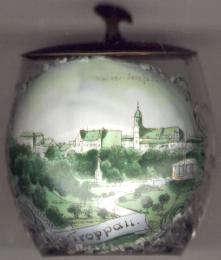 Opava (German: Troppau) is situated on the river Opava (Oppa)
near its confluence with the river Odra (Oder). It was first mentioned
in a document of 1195 and received German municipal rights in 1215/24. In 1256 it
became capital of the province Troppau and in 1318 residence of the Duchy Troppau.
Troppau became part of the courntries of the Bohemian Crown in 1511. Since
1526, when Archduke Ferdinand of Austria became King of Bohemia, Troppau belonged to Austria.
After the partition of Silesia in 1742, Troppau became the capital of the Austrian
Duchy of Silesia. At the Congress of Troppau in 1820, the monarchs of Austria (Emperor Franz I),
Prussia (King Friedrich Wilhelm III) and Russia (Czar Alexander I)
agreed to conserve the status of Europe as it had been set out by the Congress of Vienna in 1815.
In 1860, Troppau ceased to be the administrative centre of Austrian Silesia for a short while when the administration of the country was
merged with that of the Margraviate of Moravia at Brünn (Brno). However, due to massive protests,
the crownland Silesia was reestablished soon after that.
From 1918 Opava was part of the Czechoslovak Republic. From 1938 the region was part of the Sudetenland within the Third Reich before
it became part of Czechoslovakia again in 1945.
Opava (German: Troppau) is situated on the river Opava (Oppa)
near its confluence with the river Odra (Oder). It was first mentioned
in a document of 1195 and received German municipal rights in 1215/24. In 1256 it
became capital of the province Troppau and in 1318 residence of the Duchy Troppau.
Troppau became part of the courntries of the Bohemian Crown in 1511. Since
1526, when Archduke Ferdinand of Austria became King of Bohemia, Troppau belonged to Austria.
After the partition of Silesia in 1742, Troppau became the capital of the Austrian
Duchy of Silesia. At the Congress of Troppau in 1820, the monarchs of Austria (Emperor Franz I),
Prussia (King Friedrich Wilhelm III) and Russia (Czar Alexander I)
agreed to conserve the status of Europe as it had been set out by the Congress of Vienna in 1815.
In 1860, Troppau ceased to be the administrative centre of Austrian Silesia for a short while when the administration of the country was
merged with that of the Margraviate of Moravia at Brünn (Brno). However, due to massive protests,
the crownland Silesia was reestablished soon after that.
From 1918 Opava was part of the Czechoslovak Republic. From 1938 the region was part of the Sudetenland within the Third Reich before
it became part of Czechoslovakia again in 1945.
Famous sons of Opava are the czech poet Petr Bezruč (1867–1958), well-known for his Silesian Songs,
and the architect Joseph Maria Olbrich (1867–1908), one of the most important members
of the Viennese Art Nouveau and co-founder of the artists' mouvement Wiener Secession (Vienna Secession).
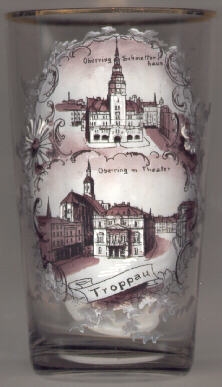 The historic centre of the town is the square Horní náměstí (Oberring, Upper Square).
The historic centre of the town is the square Horní náměstí (Oberring, Upper Square).
The  old town hall ('Schmetterhaus') [left no. 269: top]
was originally a trading house during the Middle Ages. The tower (72 m high),
called Hláska, was added in 1618.
old town hall ('Schmetterhaus') [left no. 269: top]
was originally a trading house during the Middle Ages. The tower (72 m high),
called Hláska, was added in 1618.
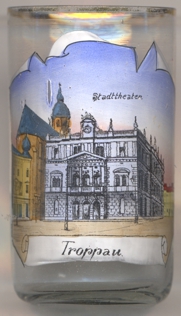
 The opposite end of the square is marked by the
The opposite end of the square is marked by the
 Silesian theatre (Slezské divadlo)
[left no. 269: bottom; right, no. 889; below no. 043: right].
Theatrical performances have a long tradition here and are documented here
as early as 1522. The first theatre building on this place was built in 1750.
The present theatre was built in 1882/83 by the architect Hubert Kmentt. The building was renovated in 1909 after a fire.
Until 1919 all performances were in German language. Between 1919 and 1938
four performances were given in Czech each month.
In 1948 a major exterior reconsruction took place, destroying the neo-Reaissance façade of 1883.
The theatre was renamed divadlo Zdeňka Nejedlého in honour of the Czech
musical scholar, journalist and politician, Zdeňek Nejedlý (1878–1962).
In 1990–1992 a further renovation restored the 1883 façade.
Silesian theatre (Slezské divadlo)
[left no. 269: bottom; right, no. 889; below no. 043: right].
Theatrical performances have a long tradition here and are documented here
as early as 1522. The first theatre building on this place was built in 1750.
The present theatre was built in 1882/83 by the architect Hubert Kmentt. The building was renovated in 1909 after a fire.
Until 1919 all performances were in German language. Between 1919 and 1938
four performances were given in Czech each month.
In 1948 a major exterior reconsruction took place, destroying the neo-Reaissance façade of 1883.
The theatre was renamed divadlo Zdeňka Nejedlého in honour of the Czech
musical scholar, journalist and politician, Zdeňek Nejedlý (1878–1962).
In 1990–1992 a further renovation restored the 1883 façade.
[http://www.andreas-praefcke.de/carthalia/europe/cz_opava_divadlo.htm]
The  Provost church Ascension of Our Lady (kostel Nanebevzetí Panny Marie)
[left no. 269: bottom left; below no. 043: centre background]
was the religious centre of the town. The church was built in gothic style
between 1360 and 1370; later, Baroque elements such as the south spire were added.
From 1645 until 1945 it was in possession of the Teutonic Order.
Provost church Ascension of Our Lady (kostel Nanebevzetí Panny Marie)
[left no. 269: bottom left; below no. 043: centre background]
was the religious centre of the town. The church was built in gothic style
between 1360 and 1370; later, Baroque elements such as the south spire were added.
From 1645 until 1945 it was in possession of the Teutonic Order.
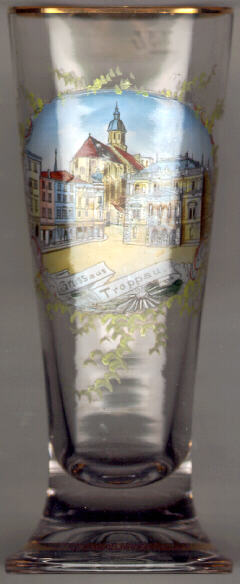
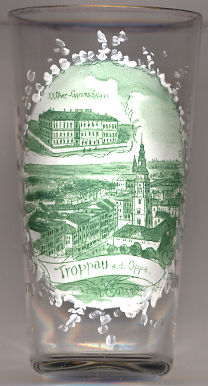 The small inset picture on glass no. 2700 [near left, no. 2700: top]
shows a view of the
The small inset picture on glass no. 2700 [near left, no. 2700: top]
shows a view of the
 k.k.
k.k.
![[scale]](lineal.jpg)